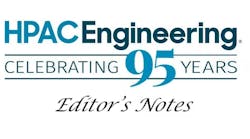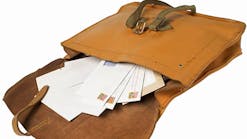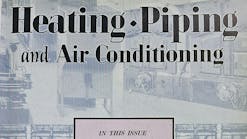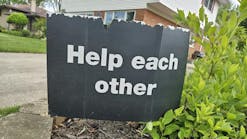By JOHN L. SHEFF, Director of Public & Industry Affairs, Danfoss North America
At this time last year, the HVAC industry was in a state of upheaval.
Half the country’s state governors were in the process of implementing the EPA’s invalidated SNAP Rules 20 & 21; the American Innovation and Manufacturing (AIM) Act seemed stalled in Congress; and California’s Air Resources Board (CARB) was moving ahead with proposed regulations that outpaced the state’s building codes. These factors, along with others, were leading to a patchwork of regulations that threatened to derail the U.S. HVAC industry’s global leadership.
A year later, however, many of those issues are now seemingly resolved and the industry is on the verge of moving toward a unified and safe transition to a new generation of low-GWP refrigerants.
California Air Resources Board (CARB)
A year ago, California was pushing ahead with proposed regulations that would put the air conditioning industry in an awkward position.
Its proposed regulation prohibiting stationary air-conditioning equipment with a GWP higher than 750 meant that — because building codes would not be updated in time to accommodate mildly flammable A2L refrigerants — there might not be legal products available on the January 1, 2023, implementation date. During the summer of 2020, the state’s fire commissioners rushed to review the new codes and standards. But when they announced that they would not update the state’s building codes ahead of the next code cycle, CARB and the industry worked together to find a solution.
CARB agreed to move its proposed implementation date for stationary air-conditioning back to January 1, 2025, and is currently working with the industry to establish a reclaimed refrigerant program that will help offset any increase in emissions due to the date change. Its implementation date and GWP limit for comfort chillers remain January 1, 2024, and 750, respectively. Meanwhile, its rules for industrial process chillers are based on discharge temperature to provide flexibility for niche low-temperature applications. In addition, the state’s supermarket industry and CARB collaborated on the following rules for grocery stores:
- Refrigerants with a GWP greater than or equal to 150 will not be allowed in new stationary refrigeration systems charged with more than 50 pounds, effective in 2022;
- Existing food retail facilities with refrigeration systems charged with more than 50 pounds must collectively meet a 1,400 weighted average GWP, or 55 percent greenhouse gas potential (GHGp) reduction relative to a 2019 baseline by 2030.
The American Innovation and Manufacturing (AIM) Act
When it was signed into law at the end of 2020, the American Innovation and Manufacturing Act, or the AIM Act, gave the U.S. EPA the authority to phase down HFCs with the same mechanism it used to phase out Ozone Depleting Substances (ODS) under the original Montreal Protocol. As opposed to SNAP Rules 20 and 21, which were vacated by the federal courts, the AIM Act does not rely on the Clean Air Act to regulate greenhouse gases. Rather, it gives the EPA the narrow authority to phase down HFCs without “opening” the Clean Air Act, which would leave the door open to regulate other sources of emissions.
The AIM Act follows the Kigali Amendment’s phasedown schedule, seeking to reduce the usage of HFCs by 85 percent in 15 years, based on a baseline which the EPA is currently developing. That baseline will be finalized by September 2021 along with allocation rules for regulated sectors. While there are no sector-based controls in the legislation, industry and environmental groups can submit petitions to the EPA asking for limits for certain sectors. The Air Conditioning, Heating and Refrigeration Institute (AHRI) is currently working with its member companies to develop sector-based controls petitions for comfort chillers, stationary air conditioning and commercial refrigeration.
It is expected that these industry petitions for stationary air conditioning and comfort chillers will closely follow what CARB has proposed, while the petition for commercial refrigeration may vary from CARB’s weighted-average GWP approach.
The Kigali Amendment
The Kigali Amendment to the Montreal Protocol is an international treaty signed in 2016 that aims to reduce greenhouse emissions from HFC refrigerants. The treaty allows each ratifying country to determine its own regulatory structure such as an outright ban, a quota system or an allocation. Thus far, more than 120 countries have ratified the Kigali Amendment, including the European Union, Japan, Australia, Mexico and Canada.
While the AIM Act’s phasedown will bring the United States into compliance with Kigali Amendment, the U.S. Senate has not ratified the treaty. Even with compliance outside of ratification, there are several reasons why AHRI and the Alliance for Responsible Atmospheric Policy are pushing lawmakers to ratify the Kigali Amendment. The U.S. has more than 30 years of leadership with the Montreal Protocol and ratifying Kigali is consistent with that legacy. In addition, failure to ratify, even with compliance through the AIM Act, risks allowing U.S. competitors to delay their own ratification until the U.S. does so.
SNAP Rules 20/21 & The U.S. Climate Alliance
To achieve the first two phasedown steps in the Kigali Amendment, the U.S. EPA under the Obama administration set a phasedown schedule for high-GWP refrigerants using rules 20 and 21 of its Significant New Alternatives Program (SNAP). These rules were used to regulate the phaseout of CFCs and HCFCs during the initial Montreal Protocol and the EPA believed the Clean Air Act gave it similar authority to act on greenhouse gases. Two refrigerant manufacturers, Mexichem and Arkema, however, sued the EPA in federal court over this interpretation and won, effectively limiting the federal government’s ability to regulate greenhouse gases without new legislation.
When President Trump announced he would withdraw the U.S. from the Paris Climate Accord, many governors from around the country formed the U.S. Climate Alliance. This group, which now includes 24 states and Puerto Rico, has pledged to implement policies that advance the goals of the Paris Climate Agreement. The Climate Alliance represents 55 percent of the U.S. population and an $11.7 trillion economy and about half of these states have included HFC regulations as part of their climate plans.
All of these states, except California, are planning to implement some form of the former SNAP Rules 20 and 21. The AIM Act’s phasedown, however, goes well beyond that of SNAP Rules 20 and 21. And while the AIM Act does not include federal pre-emption, which would prohibit states like California from regulating further than the EPA, it does obviate the need for the other Climate Alliance states’ SNAP regulations. Currently, the industry is helping the Climate Alliance states to understand the AIM Act’s phasedown and its impact on their SNAP Rules.
SNAP Rule 23
In the spring of 2020, the U.S. EPA issued a Notice of Proposed Rule Making for SNAP Rule 23. This rule proposes to list a number of A2L refrigerants as acceptable substitutes in several sectors, including:
- R-448A, R-449A and R-449B for food retail refrigeration;
- R-452B, R-454A, R-454B, R-454C, and R-457A for residential and light commercial air conditioning and heat pumps;
- R-32 for residential and light commercial air conditioning and heat pumps, excluding self-contained room air conditioners.
Once finalized, this proposed rule will help pave the way for a smooth transition to A2L refrigerants since R-32 and R-454B are the two leading low-GWP candidates to replace R-410A in residential and light commercial air conditioning applications.
Building Codes
With the passage of the AIM Act and ASHRAE and UL standards for A2L refrigerants either completed or well on their way to completion, state and local building codes that incorporate those safety standards are the next hurdle for the refrigerant transition in the United States. The AIM Act gives the U.S. EPA the authority to regulate the use of HFCs, however, it is up to states and local jurisdictions to allow for the use of mildly flammable A2L refrigerants in their building codes. Should these localities not update their building codes with the latest ASHRAE and UL safety standards ahead of the EPA’s implementation date, they risk not having legal products available to their constituents. In fact, that is exactly the choice CARB faced as it was pursuing an implementation date of January 1, 2023, for stationary air conditioning.
Currently, the International Code Council’s (ICC) International Building Codes and the International Council of Plumbing and Mechanical Officials’ (IAPMO) Uniform Mechanical Code, the two most commonly used model codes, are currently in their 2024 update cycle. During this cycle, the model code councils are reviewing the ASHRAE and UL safety standards for incorporation in the next edition of their model codes. Should these standards be adopted by the model codes councils, which is expected, states and local jurisdictions that use those model codes can incorporate them into their individual buildings codes ahead of January 1, 2025, the expected implementation date for stationary air conditioning in California and, potentially, nationwide under the AIM Act. States and local jurisdictions can also incorporate safety standards directly into their building codes without waiting for model code updates.
As AHRI works with states to help them better understand the implications of the AIM Act, the issue of local building codes is coming to the fore. In Texas, which has no statewide building codes, a novel legislative approach has emerged to ensure local building codes are ready for a national refrigerant transition. State Senators Nathan Johnson (D) and Paul Bettencourt (R) recently introduced SB 1210, legislation that would clarify that local building codes applicable to commercial or residential buildings or construction cannot prohibit the use of a substitute refrigerant allowed by the U.S EPA. The effective date of the legislation is January 1, 2023. This legislation would effectively force local jurisdictions to update their building codes to allow for A2L refrigerants, paving the way for a smooth transition in the state. AHRI and its member companies are supportive of this approach and it could emerge as a model for other states as well.
Conclusion
After a year of unprecedented uncertainty — not to mention a pandemic — a smooth U.S. refrigerant transition is finally starting to come into focus. The potential for CARB’s GWP limits and implementation dates to align with the EPA’s sector-based controls under the AIM Act create an environment in which a de facto nationwide HFC regulatory framework could actually emerge. And with model building codes on track to incorporate updated safety standards by 2024, all of the pieces are falling into place for a safe transition to low-GWP refrigerants.
##########
Based in Baltimore MD, the author joined Danfoss North America in 2014. He previously worked as a policy analyst for the office of former Gov. Martin O’Malley, where he evaluated and developed energy efficiency and renewal energy plans for the State of Maryland.









